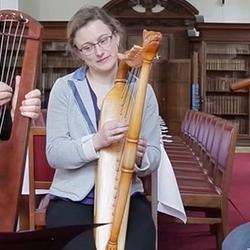
I remember the moment well. As I was putting the finishing touches to the programme a couple of days before the premiere of the lost song of Boethius, in April 2016, I suddenly realised that I had not written anything about the instruments. A brief historical introduction, a short account of the reconstruction process, biographies of the players, texts in Latin and in translation, and the list of due thanks had all been assembled, but there was nothing about the objects that would be in full sight of the audience throughout the concert.
It was more than a casual oversight. Years spent in manuscript study had focused my mind on what had seemed the central problem, namely how to reconstruct the melodies for the songs of Boethius’ On the Consolation of Philosophy. I had considered the written evidence for instrumental use and worked with the instrumentalists of Sequentia for years on issues of reconstruction, but somehow I had put the question of instruments and instrumental playing to one side as a matter of specialist interest and creative practice. With time running out I did what any self-respecting academic would do and asked the performers for short entries on the instruments.
It was not until several months later, when preparing a talk for a group of interested amateurs, that I decided to confront the gap in my knowledge. Conversations with Benjamin Bagby had convinced me that we face a problem of a failure of imagination for many medieval song repertories. We have texts that we know were sung, we know that in many cases instruments were used, and we know that instrumentalists were virtuosos whose playing enthralled audiences. To insist on reading these texts without singing them, and on performing them without instruments, is not to retreat into the safety of the known, but to experience them in a way that goes against surviving evidence.
In search of new understanding, I found myself visiting unfamiliar sections of the University Library: Archaeology, Art History and Sculpture, to name but a few. Closer to home, I turned to neglected articles in volumes I had consulted many times over. Rapid self-education followed and my mind was cast back to undergraduate lectures from Jeremy Montagu and the awe inspired by the magisterial Bate Collection in Oxford, whose threshold we rarely deigned to cross.
Even after immersive reading, questions remained. What can we learn from informed physical reconstructions? How might we read surviving historical reports, iconographic evidence and theory treatises to gain insight into playing techniques? How should we read notated evidence in the light of knowledge of possible instrumental participation? The place to seek answers once again lay before my eyes, in the experiences gained over decades by those who had experimented daily with the instruments and returned time and again to historical evidence with newly formed questions. So it was that with a first tour completed and a CD released, we returned to Cologne to begin another project: interviews with Benjamin Bagby, Hanna Marti and Norbert Rodenkirchen about their instruments and their playing techniques.
What resulted, thanks in no small part to the directorial promptings of Katya Zimmerman and the technical skills of Heiko Specht and Albrecht Maurer, was a series of short videos now released on the project website. The format for individual videos was simple: questions about the instruments, a short performance of an extract of a Boethian song, and then reflection on the playing techniques used. A final video turned to questions of ensemble, beginning with a performance and then reflecting on how the musicians interacted.
Part conversation, part lecture, part demonstration, part showcase for the close physical rapport between craftspeople and their tools, the results are intriguing. To hear friends and colleagues speak about their art honed over many years was humbling. It was performed knowledge, no doubt, but none the less interesting for capturing the insight to be gained from creative dialogues with past materials and with each other.
For those without privileged access to research libraries and professional musicians, the videos provide a window onto practices that might be imitated in preparing performances of medieval songs. For academics, they offer a rare chance to listen in detail to early music performers talking about their relationships with their instruments and decision-making prior to and during performance. Looking back at the videos, I wonder whether the instruments upstaged us again: as educators, as shapers of performance, and as an unsettling physical presence that challenged our abstractions, posing their own histories of making and re-making. We were certainly speaking about them, but at the same time they were speaking through us.
This blog post originally appeared on music@cambridge, the Research Blog of the Faculty of Music at the University of Cambridge.

